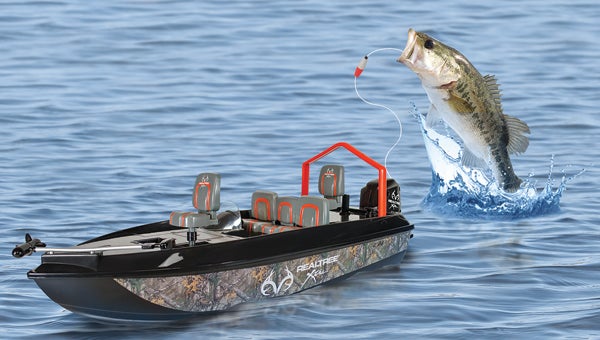Modern outdoor sportsmen enter Space Age with technology
Published 4:56 pm Monday, November 2, 2015

SIT BACK AND RELAX: This 18-inch long remote controlled fishing boat sold by Hammacher Schlemmer Co. is designed to troll for fish weighing up to two pounds each as the angler sits on the shore controlling the little boat. The boat is then guided back to the angler with fish in tow where the fish can be harvested or released.
It’s been a long time since we charted the oyster beds in the Delaware Bay by basically using a sextant to triangulate our position based on shore-based targets. In today’s world, you look at the GPS and have your present position on the water shown graphically to within one meter. The GPS, combined with an autopilot allows sport fishermen to let the boat and its’ guidance system take the boat to a pre-arranged fishing spot very accurately while the fishermen sit back and relax.
A recent fishing trip to the Big Rock off Cape Lookout was successfully programmed for navigation before the boat ever left the dock at Beaufort’s Radio Island Marina. The coordinates, supplied by other anglers, were entered into the boat’s GPS navigation system.
After first navigating through the Beaufort Inlet by visual, we turned the controls over to the autopilot, sat back and enjoyed a bumpy but precise 55-mile trip out to the “hot spot” that friends had recommended. The boat let us know when we arrived and we hastily set up rods and quickly began to take fish.
Two large electronic screens on the boat’s console showed our captain full color charts marking our exact position near the Big Rock area. It graphically displayed our progress as we trolled six ballyhoo-baited lines for miles in and about the area.
The second screen on the console gave us the water’s exact depth where we were and occasionally marked fish that we went over. Unfortunately, we didn’t have any modern equipment that enticed the fish to sample our baits. For several hours, the only fish the rods brought in were the ballyhoo baits.
Having learned earlier that there were hungry fish in the immediate position that our GPS had carried us to, the captain issued commands to the autopilot to return to that particular location where we promptly began to catch fish again.
When you’re 55 miles offshore in rough water, there’s no way possible that we could have returned to that exact spot that had produced for us earlier without all the electronic equipment that the boat had on it. We wondered how the “old timers” of years ago managed to successfully navigate these waters and consistently take home good catches when the only navigation instrument they had was a good compass.
With this bit of nautical navigation history in mind, one must wonder just where the modern fisherman of tomorrow is headed.
We anglers are beginning to see a little of what’s in store. We see that our military is using drones to fly over enemy positions where they transmit, in real time, images of what passing underneath to someone at a TV screen in America. When this modern “pilot” spots a desired enemy target, he (or she) commands the drone to fire a missile at it and — with accuracy that’s astounding even in today’s world — the target is obliterated.
Some big-time commercial fishing boats operating in international waters are currently using drones to spot schools of desirable fish and then direct the boats and their nets to the catch. Are the days of the sport fishermen using drones to locate fish that far off? For that matter, are totally radio controlled recreational boats that far in the future?
Bass Pro and Hammacher Schlemmer Companies are currently offering “Toy” radio controlled fishing boats where the angler sits on shore and directs the little boat to release trolling lines to attract fish such as our largemouth bass. When the fish bite and are hooked, the operator of the controls then directs the boat and it’s catch back to shore where the fish is harvested or released. Wildlife enforcement officials tell me that as long as all the regulations on sport fishing are obeyed (Creel & size limits, hook regulations, etc.), these radio-controlled boats are perfectly legal fishing methods.
Is tomorrow’s sport fisherman destined to sit on shore and direct the actions of his radio-controlled boat as it catches his fish for him? Today’s anglers tell me that this will never happen.
Several years ago, some big game hunters became aware that a company was using bait stations to attract bear and deer to a spot near a tower where a remote TV camera showed the animals as they fed. The “hunters” could sit in their offices thousands of miles away from where the animals were feeding and, by directing a remotely controlled rifle equipped with a telescopic sight attached to shoot at a vital area on the animal that they wanted to “harvest,” they could shoot the gun by pushing a button on their office TV screens. The animal was killed and then harvested by commercial hunting guides sitting far away from the so called “sport hunters.”
Perhaps the way these hunters used to harvest their game animals were legal but by no definition could one call these hunters “sport hunters.”
A quick outcry of the true sport hunters led to the wildlife management agencies where these remote controlled hunts were taking place having these hunts declared to be illegal and the practice went on its way to obscurity. There was absolutely no sport included in this remote controlled killing of game animals.
Current sport fishermen use GPS to navigate on the water much the same as sport hunters use their GPS’s to navigate in the woods. The hunters don’t yet have any methods in use to actually and accurately locate their game animals but there are some actual cases of aircrafts and drones beginning to show up as hunting aids.
Alaska outlaws the use of aircraft to locate game animals for two days before the actual hunt. With the now-defunct remote hunting program in mind, I expect that sport fishermen will eventually demand that their sport remain a sport and not become strictly a way to place seafood on someone’s plate. That is left up to the commercial fishermen who make their livings on the water and they are just as much part of our American culture as the American sport hunters and fishermen.
Modern marine electronics are an accepted part of both the commercial and sport fishing industries, but no one ever hears of the sport of commercial fishing. Some states place strict limits on the amount of fish that sport and commercial fishermen can sell and that ‘s a good idea. Many sport fishermen now prefer to be collectively called “anglers” these days.
That’s also a good idea.





